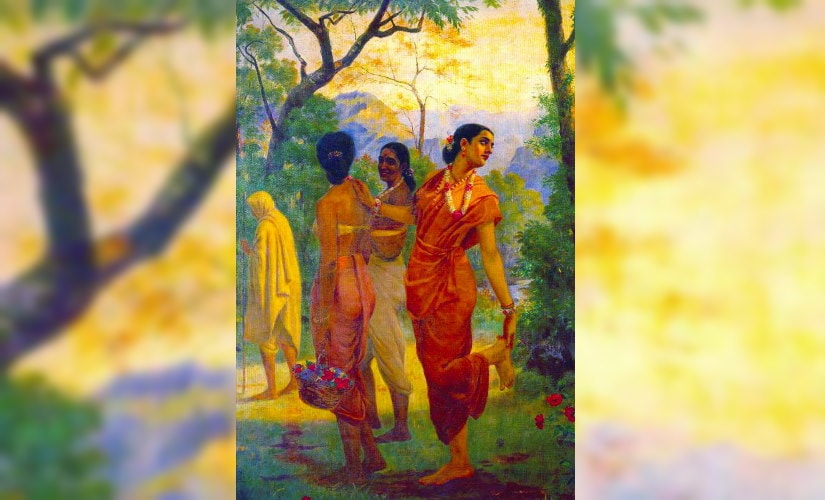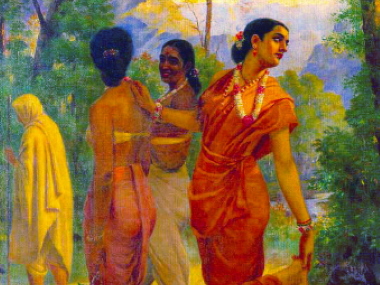I have this print of Raja Ravi Varma’s Shakuntala on the wall of the staircase leading up to our house. Perhaps you know it. It shows three young women in the woods, mountains in the background. Two of the women are talking to each other, the one who has her head turned away from us is carrying a basket of flowers. And then there’s a third woman, her hand resting on her companion’s shoulder for balance as she grips the base of her foot, apparently pretending to take a thorn out of her heel so she can take a backwards look at her lover. We see her face, but she’s not looking out at us. Instead, her whole form is one of yearning, her mouth is unsmiling, her eyes eager, her shoulders tilted backwards, so much does she long to be in a part of the painting that we cannot see. There’s also an old woman walking ahead of the younger ones, but if there is an explanation for who she is, I cannot find it. [caption id=“attachment_7261651” align=“alignnone” width=“825”]  Shakuntala, by Raja Ravi Varma. Image via WikimediaCommons[/caption] Ironically, Shakuntala, the heroine of perhaps one of the best-known love stories in Hindu mythology, was not born from a place of love. I’ve written about her sage dad/apsara mom before in this column, but let’s recap: [Sage Vishvamitra] was chugging along at his meditations when the god Indra decided to test him — the gods were big on surprise quizzes — and sends Menaka down to earth to seduce him. Menaka was an apsara, a celestial woman created just for sensual pleasure in heaven for men and gods, no word yet on what the women got. Duly seduced, Vishvamitra lives with Menaka for ten years, and then she eventually has a kid, a daughter named Shakuntala, at which point Vishvamitra’s suddenly terrorised by the idea of fatherhood and curses her into becoming super ugly in her next birth. Anyway, this baby was found by another sage, but a much kinder one, a guy called Kanva, who found her in the reeds where Vishvamitra abandoned her, but surrounded by sakunta birds, who, much like the wolves and Mowgli, were doing a pretty good job looking after her and keeping her alive. (Unclear about which birds, but the Sambhava Parva book of the Mahabharata does mention vultures were keeping an eye on her, which would be curiously against the common perception of those much-maligned birds as evil or scavenging creatures.) So Kanva calls the baby Shakuntala, ie person protected by birds, and raises her in his ashram, where she lives an idyllic Disney princess type existence, little birds dressing her each morning, lots of fresh air and activities, some young friends who think the world of her and so on. She grows to young womanhood in this innocent environment and that’s when the trouble starts. Of course, the problems all begin with a man barging in where he’s not wanted. Dushyant is hunting and shoots a deer, but he can’t find it, because the creature’s limped off, so he tracks it and stumbles upon the ashram where he sees Shakuntala nursing the deer, and he’s overwhelmed by her beauty and wants to have sex with her right there on the ashram floor so he suggests a Gandharva marriage, which is this very interesting loophole to the traditional Hindu wedding ceremonies with like, ten days of pomp and circumstance. It’s one of the eight classical forms of Hindu weddings (more on this in a future column!) and is solely dependent on the bride and groom taking a fancy to each other. In fact, it’s super important that the bride is into the groom in this case, because it was one of the few times that women had control over their futures. You didn’t need a priest, and most importantly, you didn’t need your parents’ consent. Obviously, as time went on, and patriarchy tightened its views about women as property, this sort of wedding fell out of fashion, but it did see a nice lot of weddings in its time. Although the Shakuntala-Dushyanta story should not be used as an example for a successful Gandharva wedding. After he marries her, he has to go off back to his kingdom, and he’s like, “Okay, make up a party and come to me when you’re ready.” In Kalidasa’s version, which I’m using as canon here, since that’s the story people are most familiar with: Dushyanta gives his wife a ring, so she can identify herself as his wife, and then leaves. She’s pregnant at this point, but no one knows that yet. So, she’s mooning about, dreaming about Dushyanta and generally being a sixteen year old in love, when the sage Durvasa, whose role is basically to curse people and move a story along, appears in her dad’s ashram. Because she’s lost in thought and does not immediately jump to do his bidding, he tells her that whoever she’s thinking about will forget her, just like she’s forgotten Durvasa. Great guy, Durvasa. Really a pearl among sages. (Did he ever curse men or was all his rage reserved for women?) So of course, our heroine loses the ring her husband gave her and turns up at his kingdom with her dad and extended friends from the ashram, only for Dushyanta to tell her he’s never met her before in his life. Worse, he’s all, “How do I even know this baby is mine?” Weeping, Shakuntala leaves, and that’s the end of the story for about three or four years, until a fisherman shows up with a ring he’s found in the belly of a fish. It’s—duh—Shakuntala’s missing ring, and Dushyanta goes in search of her, we’re hoping he’s kicking himself after doing all that royal ghosting. He finds a little boy wrestling a lion, it’s his son! Bharat! And the family is reunited and that’s I think the last we hear about Shakuntala. Kalidasa made Dushyanta into a more sympathetic guy though. In the Mahabharata, Shakuntala goes to him only after she’s had her son, and reminds him that he promised to make their son his heir. Dushyanta remembers but pretends not to, and says he has no idea who she is. Shakuntala makes a plea for her own behalf, tells him she’s a good wife and it’s a sin to cast her and their son aside and so on, a nice flowery speech, to which Dushyant says (and I will quote directly from the text here, so you can see what a dirtbag he is): “O Shakuntala, I do not know having begot upon thee this son. Women generally speak untruths. Who shall believe in thy words? Destitute of all affection, the lewd Menaka is thy mother, and she cast thee off on the surface of the Himavat as one throws away, after the worship is over, the flowery offering made to his gods. Thy father too of the Kshatriya race, the lustful Viswamitra, who was tempted to become a Brahmana, is destitute of all affection. However, Menaka is the first of Apsaras, and thy father also is the first of Rishis. Being their daughter, why dost thou speak like a lewd woman?” Wow. I hope Shakuntala was able to forgive Dushyanta after all that — no matter what version of the story you prefer, he still forgot her and their kid. Read more from the ‘Mythology for the Millennial’ series here . Meenakshi Reddy Madhavan is the author of several books, including The One Who Swam with the Fishes: Girls of the Mahabharata. She tweets @reddymadhavan
On Shakuntala, the heroine of perhaps one of the best-known love stories in Hindu mythology.
Advertisement
End of Article


)
)
)
)
)
)
)
)
)



